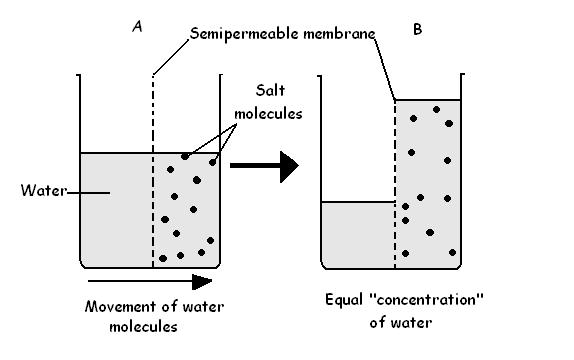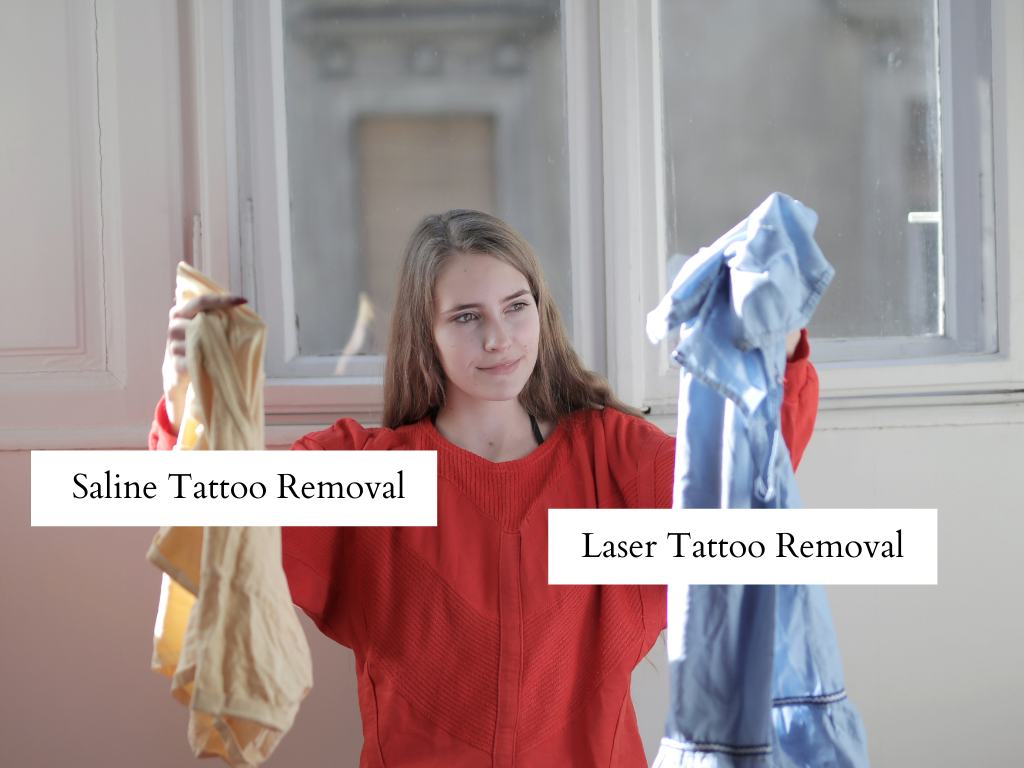Let’s discuss one of the lesser-known methods of tattoo removal – saline solution tattoo removal. Is it a safe choice?
Saline Tattoo Removal
In this removal method, a hypertonic saline solution of salt and purified water, and often other natural ingredients (lemon seed extracts, aloe, etc.) is applied to the tattooed area. The saline solution works on the tattoo through the science of osmosis. According to Merriam Webster, osmosis is “the movement of a solvent (such as water) through a semipermeable membrane (as of a living cell) into a solution of higher solute concentration that tends to equalize the concentrations of solute on the two sides of the membrane.”

Here the skin acts as the porous membrane. Saline solution is first inserted into the tattooed skin. The tattoo pigment then moves upwards to the surface with it. Earlier, saline removal simply meant rubbing a pod of saline and a salt onto the tattoo. This can be a painful experience and is not recommended.
Does saline tattoo removal work?
This technique works best against small tattoos (no bigger than the size of a playing card), cosmetic tattoos or permanent makeup, and microblading. It is not advisable for large tattoos – the procedure will take too long to show any significant change. It may also be a riskier choice of treatment compared to laser removal in many cases.
Saline Tattoo Removal Process
First, the tattoo area is disinfected. Numbing cream or other local anesthesia is applied to the region to reduce pain and discomfort during the treatment process. The technician then uses a machine similar to a tattoo ink gun to penetrate the skin and release the saline solution into the skin. The tattoo pigment is pulled out to the surface as a result of osmosis caused by the saline solution. The newly surfaced pigments develop into a scab that will peel off naturally, leaving behind a lighter version of the original tattoo. Repeat this process till the desired result is achieved.
Saline Tattoo Removal Pain

The actual pain experienced may vary with individual tolerance level. Generally, a numbing cream is applied to reduce discomfort during the process. The needle piercing is very similar to the tattooing process. For some, this may be a stinging sensation. Minor bruises or bleeding may happen during the procedure. The treated area may also feel tender for the next few days.
Saline Tattoo Removal Cost
While each establishment may have different prices, the average pricing is around $100-$200.
How many sessions needed?
The average duration of each session may vary between 30 minutes to over an hour. The numbing cream will also need some time to kick in.
For some tattoos, one session might do the trick. Others may need a few more sessions (3-6 sessions) before the desired result is achieved. Factors like age, size, colors, location, and depth of ink will impact the length of the healing process. Sessions must be at least 4-6 weeks apart.
Can you undergo this treatment?
The saline tattoo removal process is not suitable for everyone. This is also not an appropriate solution for removing medium-sized or large tattoos. Pregnant and breastfeeding women are not eligible for this treatment choice. People suffering from skin diseases (like keloids), infections, hypersensitivity, heart problems, high blood pressure, diabetes, epilepsy, hemophilia, cancer, and open wounds cannot undergo this procedure. No use of Accutane for the past one year is also a compulsory requirement to be eligible for a safe saline removal procedure. It is advisable to have a detailed consultation with the technician to know if your medical conditions and medications are a hindrance to the process. Diabetics and smokers will witness slower healing.
Saline removal is suitable for all skin types. Dark-skinned patients do not face greater risks of hyperpigmentation or hypopigmentation as they do in laser removal.
Preparations before a removal session
For 24 hours before the treatment, alcohol and caffeine must be strictly avoided. Do not consume blood-thinning medications like Aspirin, Plavix, etc., for a couple of days before the appointment. If these medicines are a medical necessity, do not stop their consumption before doctor approval. Avoid using fish oil and skin products on the tattoo. Also do not entertain treatments like botox, chemical peels, facials, microdermabrasion, etc. for at least two weeks before the treatment. Do not work out on the day of treatment. Protect the skin from the sun for at least two weeks. Sunburnt skin is not ideal for the treatment process.
Saline Tattoo Removal Healing Process
Do not cover the treated region. Remove the bandages 30-45 minutes after the procedure, no more and no less. This is because oxygen will ensure an effective and quicker healing process. In the next couple of days, the tattoo will see a scab formation. It may take a few weeks before the scab falls off. It is vital to keep the area clean and dry during this time. Avoid any activity that might make this region wet – be it swimming, exercise, sauna, or tanning. Do not use any skincare or makeup products in and around the treated area. Furthermore, there should be no touching, rubbing, scratching, or picking! The scab must come off on its own. Such interference may lead to scarring or even hinder the healing process. After the scab has fallen off, nourish the treated region with Vitamin E ointment or oil regularly. This will lower the chances of scarring or discoloration as an after effect. Sunscreen and healing ointment must be applied only after the scab has come off COMPLETELY.
Laser v/s Saline Tattoo Removal

A laser tattoo removal uses a laser to break the tattoo ink particles into smaller fragments. The immune system then discards these particles. On the other hand, saline tattoo removal uses a saline solution to bring the tattoo pigments to the outer skin surface through osmosis. It then develops into a scab that falls off naturally, leaving behind a lighter version of the tattoo. Both these processes need time, laser removal generally being a longer process. In laser removal, different tattoo colors need lasers of different wavelengths. Some colors, like white, cannot be removed with laser treatment. In saline removal, however, the saline solution attacks all tattoo pigments, irrespective of color. The lighter colors are easier to remove in saline removal, whereas darker shades are quicker to fade in laser removal. Laser removal is also generally costlier than saline removal.
Nonetheless, laser removal is the safer and more effective choice of treatment for conventional tattoos. It is because saline removal creates an open wound that has higher risks of scarring and infection. But cosmetic tattoos generally respond better to saline removal.
Tattoo removal at home with salt
Trying this at home is not advised. According to the American Academy of Dermatology (AAD), scrubbing a tattoo with a solution of salt and water is a ‘dangerous strategy’. It can cause pain, scarring, and even a serious infection.




